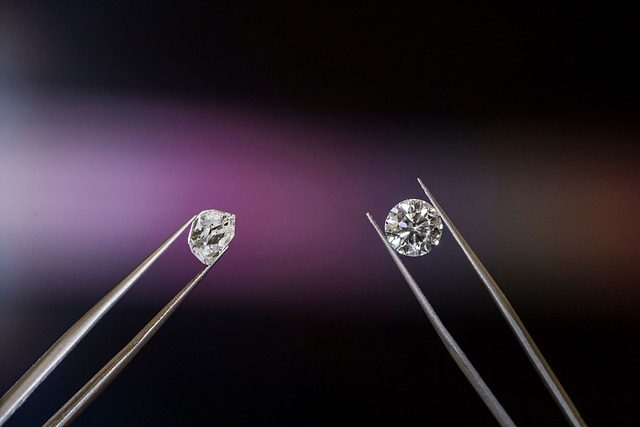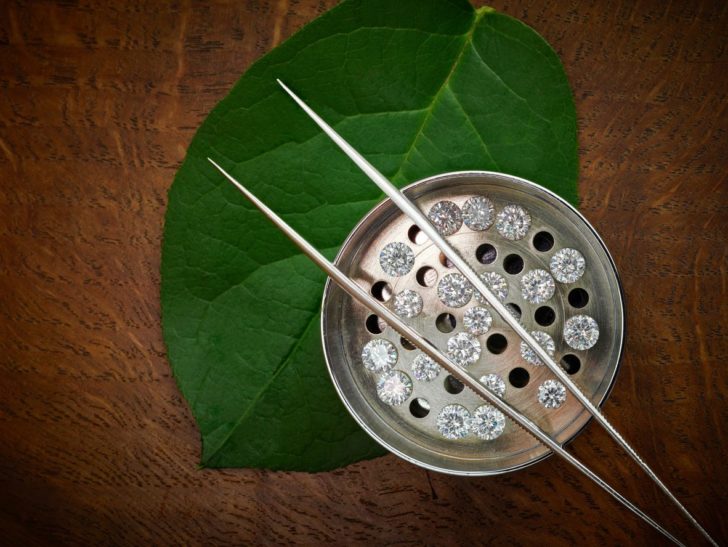Imagine a diamond that possesses all the beauty and brilliance of a natural gemstone, yet is produced in a controlled laboratory setting. An innovative and ethical alternative to traditionally mined diamonds, lab-grown diamonds are revolutionizing the world of fine jewelry. In this journey through the fascinating realm of lab-grown diamonds, we’ll explore the science behind their creation, their characteristics, and the various reasons why they are an attractive choice for consumers.
Delve into the world of advanced technology as we unveil the secrets behind lab-grown diamonds, their ethical and environmental advantages, and how they compare to natural diamonds and diamond simulants. Discover the rare beauty of colored lab-grown diamonds and the popular jewelry styles featuring these stunning gemstones. Let’s begin!
Table of Contents
Key Takeaways
Lab-grown diamonds are chemically and optically identical to natural counterparts, with unique colors and shapes.
They provide ethical and environmental advantages, along with quality assurance for discerning customers.
Lab grown diamonds offer a great value proposition due to their lower cost, transparency of sourcing, exceptional quality & beauty.
The Science Behind Lab Grown Diamonds

Lab-grown diamonds, also known as lab-created diamonds, are produced in highly controlled laboratory environments through advanced technological processes that replicate the conditions in which diamonds naturally form beneath the Earth’s crust. These sophisticated techniques result in lab diamonds that are chemically indistinguishable from natural diamonds, making a lab created diamond a desirable choice for modern consumers.
Two techniques are used for producing lab-grown diamonds: Chemical Vapor Deposition (CVD) and High Pressure High Temperature (HPHT). These methods enable diamond manufacturing in a laboratory setting. Each method offers its unique advantages, but both produce lab-grown diamonds that are chemically and optically identical to their natural counterparts.
Understanding how these two groundbreaking techniques work and their differences is crucial.
Chemical Vapor Deposition (CVD)
The Chemical Vapor Deposition (CVD) method involves the use of a diamond seed. It is placed in a small vacuum chamber which is filled with a combination of heated hydrogen and carbon-containing gases. As the temperature reaches around 1500 degrees Fahrenheit, the gas molecules break down, and layers of crystallized carbon begin to form around the seed, eventually producing a larger diamond.
The CVD process offers several advantages:
Cost-effectiveness
Efficient fabrication of lab-grown diamonds with the same chemical and optical properties as natural diamonds
Ability to produce diamonds in distinctive colors and shapes that are not available in nature
These advantages make the CVD process an appealing choice for those seeking unique gemstones.
High Pressure High Temperature (HPHT)
The High Pressure High Temperature (HPHT) method replicates the natural conditions in which diamonds form within the Earth’s mantle. In this process, a machine compresses a specific quantity of carbon material under pressures of more than 870,000 lbs. per square inch at extreme temperatures ranging from 1300 – 1600 degrees Celsius.
The HPHT method:
is a reliable and cost-effective approach for producing lab diamonds comparable in quality to natural diamonds
enables the production of diamonds in a plethora of colors
is an excellent option for those seeking a unique and beautiful diamond.
The Quality and Characteristics of Lab Diamonds
Lab-grown diamonds are identical to natural diamonds in terms of both chemistry and optics, demonstrating the same fire, scintillation, and sparkle. They possess the same physical, chemical, and optical characteristics as those of natural and lab diamonds, making them a viable alternative for discerning consumers.
Unlike natural diamonds, which form deep within the Earth, lab-grown diamonds are manufactured in a laboratory. While lab diamonds have the same chemical composition as natural diamonds, lab and synthetic diamonds possess different chemical compositions and are often composed of materials such as cubic zirconia or moissanite.
Specialized testing is required to distinguish lab-created diamonds from real diamonds, confirming their quality and authenticity.
Colored Lab Grown Diamonds: A Rare Beauty

In addition to their ethical and environmental benefits, lab-grown diamonds also offer the possibility of creating rare and stunning colored diamonds. Starting from a rough diamond, through modification of the gas mix in the CVD reactor and post-synthesis treatments, lab-grown diamonds can be produced in rare hues like vivid yellows, blues, and pinks.
Lab-grown diamonds with fancy colors are formed when trace elements are added during the growing phase, similar to the formation of natural diamonds. In both cases, tiny amounts of these particles are necessary. These mesmerizing hues add a touch of uniqueness and elegance to any piece of jewelry, making colored lab-grown diamonds an attractive choice for those seeking something truly extraordinary.
Ethical and Environmental Advantages
Opting for lab-grown diamonds instead of natural ones offers several benefits:
Cost savings
Positive contributions to ethical and environmental concerns
Reduction in the need for diamond mining, which can have detrimental environmental and social effects
Smaller carbon footprint than mined diamonds, making them a more sustainable choice for eco-conscious consumers.
Brands like Brilliant Earth and the Truly Brilliant™ Collection prioritize the planet by offering lab-grown diamonds crafted from renewable energy sources and ensuring that their diamond suppliers are audited for safe and healthy working conditions. By choosing lab-grown diamonds, you are making a responsible and sustainable choice that aligns with your values.
Grading and Certification of Lab Grown Diamonds
Lab-grown diamonds are graded and certified to the same criteria as natural diamonds to ensure their quality and authenticity. Trained gemologists closely examine the diamonds and assign grades based on the ‘Four C’s’:
Color
Clarity
Cut
Carat weight
The grading process for lab-grown diamonds is analogous to that of natural diamonds, ensuring that the diamonds you choose meet the highest standards.
By adhering to the same grading and certification process as natural diamonds, lab-grown diamonds provide consumers with the confidence and assurance that they are purchasing a high-quality and authentic diamond. This transparency and attention to detail make lab-grown diamonds an attractive option for those seeking the perfect gemstone.
Pricing and Value of Lab Grown Diamonds
Offering excellent value, lab-grown diamonds are about 50% cheaper than mined diamonds of similar quality. This affordability allows consumers to invest in larger stones or more intricate designs without breaking the bank.
In addition to their lower cost, lab-grown diamonds also come with the assurance of quality and transparency in sourcing. With a discernible source and no connection to conflict or unethical practices, lab-grown diamonds provide an improved value proposition for those looking to make an informed and responsible jewelry purchase.
Popular Jewelry Styles Featuring Lab Grown Diamonds
Lab-grown diamonds find use in a multitude of jewelry styles, including:
Engagement rings
Earrings
Necklaces
Bracelets
Their versatility and exceptional quality make them a popular choice for those seeking unique and stunning jewelry pieces.
Whether you’re looking for a dazzling engagement ring or a stunning pair of earrings, lab-grown diamonds offer an unparalleled combination of beauty, quality, and value. With a vast array of shapes and designs available, there’s something to suit every taste and style when it comes to lab-grown diamond jewelry.
Lab Grown Diamonds vs Diamond Simulants
Unlike diamond simulants like cubic zirconia or moissanite, lab-grown diamonds are chemically identical to natural diamonds. Diamond simulants may appear similar to natural diamonds but lack the same chemical and optical properties, making them an inferior option for those seeking the quality and durability of a real diamond.
Gemologists can differentiate between diamond and moissanite based on their contrasting refractive properties, as moissanites are double refractive while diamonds are single refractive. When it comes to choosing between lab-grown diamonds and diamond simulants, lab-grown diamonds offer a more authentic and higher-quality alternative.
Maintenance and Care for Lab Grown Diamond Jewelry
Maintaining the lasting beauty and durability of your lab-grown diamond jewelry requires proper care and maintenance. Lab-grown diamonds can be cleaned in the same manner as natural diamonds, using either ultrasonic cleaners or a milder jewelry cleaning solution.
Regular cleaning and inspection of your lab-grown diamond jewelry will help maintain its sparkle and brilliance, ensuring that it remains a stunning and cherished piece for years to come. Treat your lab-grown diamond jewelry with the same care and attention as you would any natural diamond, and it will continue to shine brightly for everyday wear and special occasions alike.
Reasons to Choose Lab Grown Diamonds
The decision to choose lab-grown diamonds is supported by numerous compelling reasons such as affordability, ethical considerations, and environmental benefits. Their lower cost allows consumers to invest in larger stones or more intricate designs without compromising quality or authenticity.
Furthermore, lab-grown diamonds are not associated with conflict or unethical practices, eliminating the risk of purchasing a blood diamond. They also have a smaller environmental impact than mined diamonds, making them a more sustainable and responsible choice for eco-conscious consumers seeking a mined diamond alternative.
With all these advantages in mind, lab-grown diamonds are an increasingly popular option for those seeking beautiful, high-quality, and ethically sourced gemstones.
Learn more, visit Five reasons to choose lab-grown diamonds.
Summary
Throughout this exploration of the fascinating world of lab-grown diamonds, we have uncovered the science behind their creation, their quality and characteristics, and the numerous reasons why they are an attractive choice for consumers. From their ethical and environmental advantages to their affordability and stunning beauty, lab-grown diamonds offer a compelling alternative to traditional mined diamonds.
Embrace the future of fine jewelry by considering lab-grown diamonds for your next jewelry purchase. With their impeccable quality, lasting durability, and ethical considerations, lab-grown diamonds are a brilliant choice for those seeking a truly exceptional and sustainable gemstone.
Frequently Asked Questions
Is a lab-grown diamond a real diamond?
Lab grown diamonds are just as real as mined diamonds, with the same chemical, physical, and optical properties. They exhibit the same fire, scintillation, and sparkle, making them indistinguishable from mined diamonds.
What are the disadvantages of lab-grown diamonds?
Lab-created diamonds lack the same rarity, uniqueness and meaning as natural stones, are not likely to hold their value over time and are more affordable than mined diamonds.
Can a jeweler tell if a diamond is lab-created?
Yes, a jeweler can tell if a diamond is lab-created by using specialized equipment such as a diamond tester or microscope. Lab diamonds have distinct laser inscriptions that identify them as lab-made which can be viewed through loupes or microscopes, and the only way to be 100% sure if the diamond is lab grown or natural is by checking its certificate and laser inscription. However, it is important to note that not all lab-created diamonds have laser inscriptions, so it is not always possible to tell if a diamond is lab-created or natural just by looking at it. In these cases
How are colored lab-grown diamonds produced?
Colored lab-grown diamonds are created by altering the gas mix used in a CVD reactor and subsequent treatments post-synthesis.
How are lab-grown diamonds graded and certified?
Lab-grown diamonds are graded and certified according to the 4 Cs of cut, color, clarity, and carat weight, just like natural diamonds.









